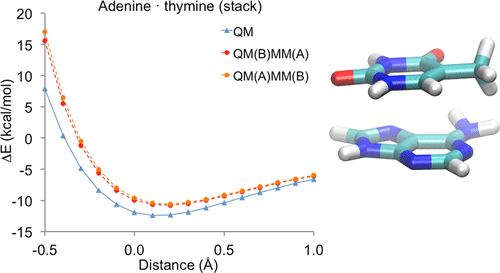当前位置:
X-MOL 学术
›
J. Chem. Theory Comput.
›
论文详情
Our official English website, www.x-mol.net, welcomes your
feedback! (Note: you will need to create a separate account there.)
Density-Dependent Formulation of Dispersion–Repulsion Interactions in Hybrid Multiscale Quantum/Molecular Mechanics (QM/MM) Models
Journal of Chemical Theory and Computation ( IF 5.7 ) Pub Date : 2018-02-13 00:00:00 , DOI: 10.1021/acs.jctc.7b00912 Carles Curutchet 1 , Lorenzo Cupellini 2 , Jacob Kongsted 3 , Stefano Corni 4, 5 , Luca Frediani 6 , Arnfinn Hykkerud Steindal 6 , Ciro A. Guido 7 , Giovanni Scalmani 8 , Benedetta Mennucci 2
Journal of Chemical Theory and Computation ( IF 5.7 ) Pub Date : 2018-02-13 00:00:00 , DOI: 10.1021/acs.jctc.7b00912 Carles Curutchet 1 , Lorenzo Cupellini 2 , Jacob Kongsted 3 , Stefano Corni 4, 5 , Luca Frediani 6 , Arnfinn Hykkerud Steindal 6 , Ciro A. Guido 7 , Giovanni Scalmani 8 , Benedetta Mennucci 2
Affiliation

|
Mixed multiscale quantum/molecular mechanics (QM/MM) models are widely used to explore the structure, reactivity, and electronic properties of complex chemical systems. Whereas such models typically include electrostatics and potentially polarization in so-called electrostatic and polarizable embedding approaches, respectively, nonelectrostatic dispersion and repulsion interactions are instead commonly described through classical potentials despite their quantum mechanical origin. Here we present an extension of the Tkatchenko–Scheffler semiempirical van der Waals (vdWTS) scheme aimed at describing dispersion and repulsion interactions between quantum and classical regions within a QM/MM polarizable embedding framework. Starting from the vdWTS expression, we define a dispersion and a repulsion term, both of them density-dependent and consistently based on a Lennard-Jones-like potential. We explore transferable atom type-based parametrization strategies for the MM parameters, based on either vdWTS calculations performed on isolated fragments or on a direct estimation of the parameters from atomic polarizabilities taken from a polarizable force field. We investigate the performance of the implementation by computing self-consistent interaction energies for the S22 benchmark set, designed to represent typical noncovalent interactions in biological systems, in both equilibrium and out-of-equilibrium geometries. Overall, our results suggest that the present implementation is a promising strategy to include dispersion and repulsion in multiscale QM/MM models incorporating their explicit dependence on the electronic density.
中文翻译:

混合多尺度量子/分子力学(QM / MM)模型中色散-排斥相互作用的密度依赖公式
混合多尺度量子/分子力学(QM / MM)模型被广泛用于探索复杂化学系统的结构,反应性和电子性质。尽管此类模型通常分别在所谓的静电和可极化嵌入方法中分别包括静电和潜在极化,但是尽管具有量子力学起源,但通常通过经典电势来描述非静电扩散和排斥相互作用。在这里,我们提出了Tkatchenko-Scheffler半经验范德华(vdW TS)方案的扩展,旨在描述QM / MM可极化嵌入框架内量子与经典区域之间的色散和排斥相互作用。从vdW TS开始表达式中,我们定义了一个色散和一个排斥项,它们都依赖于密度并且始终基于类Lennard-Jones势。我们针对基于vdW TS的MM参数探索基于可转移原子类型的参数化策略对孤立的碎片进行计算,或者根据可极化力场中的原子极化率直接估算参数。我们通过计算S22基准集的自洽相互作用能来研究实现的性能,S22基准集旨在代表生物系统中平衡和非平衡几何中的典型非共价相互作用。总体而言,我们的结果表明,本实施方案是一种有前途的策略,可将色散和斥力纳入其明确依赖于电子密度的多尺度QM / MM模型。
更新日期:2018-02-13
中文翻译:

混合多尺度量子/分子力学(QM / MM)模型中色散-排斥相互作用的密度依赖公式
混合多尺度量子/分子力学(QM / MM)模型被广泛用于探索复杂化学系统的结构,反应性和电子性质。尽管此类模型通常分别在所谓的静电和可极化嵌入方法中分别包括静电和潜在极化,但是尽管具有量子力学起源,但通常通过经典电势来描述非静电扩散和排斥相互作用。在这里,我们提出了Tkatchenko-Scheffler半经验范德华(vdW TS)方案的扩展,旨在描述QM / MM可极化嵌入框架内量子与经典区域之间的色散和排斥相互作用。从vdW TS开始表达式中,我们定义了一个色散和一个排斥项,它们都依赖于密度并且始终基于类Lennard-Jones势。我们针对基于vdW TS的MM参数探索基于可转移原子类型的参数化策略对孤立的碎片进行计算,或者根据可极化力场中的原子极化率直接估算参数。我们通过计算S22基准集的自洽相互作用能来研究实现的性能,S22基准集旨在代表生物系统中平衡和非平衡几何中的典型非共价相互作用。总体而言,我们的结果表明,本实施方案是一种有前途的策略,可将色散和斥力纳入其明确依赖于电子密度的多尺度QM / MM模型。











































 京公网安备 11010802027423号
京公网安备 11010802027423号